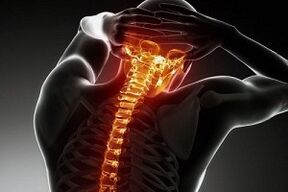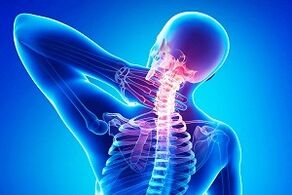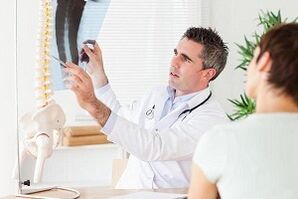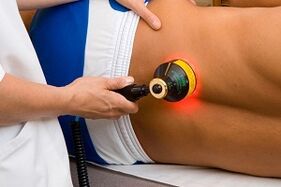
Osteochondrosis is a spinal pathology that affects millions of people of all ages.
Degenerative and dystrophic changes in the intervertebral disc, the proliferation of osteophytes cause pain syndrome, reduced mobility of the support space. Symptoms depend on the area affected.
In most cases, negative manifestations not only affect the support column and paravertebral zone, but also spread to other areas.
If there is no treatment, the disease progresses, the work of organs and systems is disrupted, his health condition worsens, persistent pain and complications against a pathological background can lead to disability.
It is important to know what is osteochondrosis, the causes of common diseases, methods of treatment and prevention.
The causes of the development of this disease

Degenerative and dystrophic processes in the intervertebral disc, excessive oxidation in the affected area develop in the following cases:
- back injuries;
- high loads on support poles during hard work, professional sports, carrying loads;
- congenital malformations of the support column;
- lack of vitamins, minerals, deterioration of the quality of cushions;
- violation of mineral metabolism;
- hormonal disorders, endocrine diseases;
- lack of movement, inactive work;
- severe obesity;
- decreased elasticity of the intervertebral disc in the elderly, with aging of the body;
- strong coffee intake, carbonated beverages and alcohol, sour foods, smoked meats, smoking;
- tumor processes in the paravertebral zone, provoking damage to the elastic structure of the spine.
Types and rankings
Osteochondrosis affects all parts of the support column. More active degenerative processes are shown in the moving areas: lumbar and cervical, in the thoracic zone, damage to the vertebrae, bone tissue is rare.
Depending on the area affected, there are several types of osteochondrosis:
- cervix;
- dada;
- lumbosacral.
Stage of pathology:
- First stage- the development of chondrosis. Lack of nutrients impairs the quality of the disc, and the elasticity of the cushion pad decreases. High load against the background of thinning of cartilage tissue provokes mild to moderate pain in the spine;
- second level.Deformation of the elastic structure is more pronounced, pain appears not only during loading, but also when bending, twisting. Defeat of the fibrous annulus causes pinching of sensitive structures, increased friction of bone elements;
- third stage.The integrity of the annulus fibrosus is damaged, the disc protrudes beyond the vertebrae, pain syndrome is pronounced. It is difficult for patients to do without medications that reduce discomfort. Against the background of destruction of the elastic pad, the movement of the support pole decreases, protrusion and intervertebral hernia develop;
- fourth stage.The cartilaginous layer is almost absent, osteophytes appear in the spine. Bone growth is an effort to compensate for the excessive load on the affected vertebrae. The compact element stabilizes the spine, but at the same time reduces the mobility of the problem area on the support pole. In the fourth stage of osteochondrosis, the pain subsides, but the patient has difficulty performing moderate movements. If changes occur in the lumbosacral area, then paresis or paralysis of the lower body may occur. Often, in the fourth stage of osteochondrosis, the patient develops a deformity.
On a note!Support column disease occurs with a period of remission (from a few months to a year or more) and an increase (period of relapse, intensity of pain depends on many factors).
The first signs and symptoms

The manifestation of the disease depends on the degree and the part affected.
The more negative factors, the higher the risk of pain syndrome, damage to other areas.
Blood circulation is impaired, mineral metabolism is disturbed, protrusion, vertebral hernia develops, excessive ossification appears in the affected area.
Self -medication, lack of qualified help, combined with the refusal to visit a vertebrologist on a regular basis, has a negative impact on the state of the vertebral structure.
Cervix
The main signs are:
- radicular syndrome with severe disc damage;
- pain in the back of the head, neck, crown;
- dizziness, fainting;
- Headache;
- discomfort in the muscles of the shoulders, neck;
- numbness of the cervical zone, hands, fingers;
- discomfort in the chest area;
- cervical spine movement disorders;
- decreased or lost shoulder muscle reflexes;
- feeling of "goose bumps" on hands, fingers;
- with osteochondrosis of the cervical spine, a person is tormented by insomnia, a depressed state, irritability with a background of excruciating pain in the neck and head.
Osteochondrosis of the chest
Special signs:
- with prolonged stay in one position, heavy loads, bends, bends, chest pain appear;
- with deep breathing, discomfort of varying intensity is felt in the middle of the back;
- while raising the hands, moving the body, the pain increases;
- with the development of osteochondrosis of the thoracic region, problems appear in the work of the gastrointestinal tract;
- in the hand there is an unpleasant feeling of "goose bump";
- depending on the degree of damage, doctors distinguish dorsalgia - a painful sensation in the affected spine and dorsago - acute pain, pain of high intensity, shortness of breath, causing muscle spasms;
- developing intercostal neuralgia;
- pain or acute pain in the shoulder blade area;
- reproductive disorders occur.
Lumbosacral region

The main symptoms are:
- discomfort of varying intensity in the lower back;
- muscle weakness, development of paresis;
- coldness and numbness in the lower legs;
- pain syndrome pronounced with heavy loads or lifting weights;
- lumbago lumbago pain appears: pain radiating from the lower back to the gluteal zone, groin, legs;
- intermittent claudication develops;
- nerve compression adversely affects the work of the pelvic organs: with severe degrees of lumbosacral osteochondrosis, urinary incontinence, involuntary defecation is possible;
- fatigue appears, difficulty in standing, long walks cause weakness in the legs.
Diagnostics
To clarify the condition of the spine, you need to contact a vertebrologist. If there is no doctor of this specialization, you should see a neurologist or orthopedic traumatologist.
Diagnostic steps:
- Patient examination, complaint examination.
- MRI.
- CT.
- X-ray of the spine in some projections.
- Doppler ultrasonography of blood vessels.
- Electromyography.
Effective treatment
How to treat osteochondrosis? Chronic pathology requires attention from physicians and patients. Do not expect that the negative symptoms will disappear a week after the start of therapy. Only an integrated approach yields results. Patients must understand that medication alone cannot eliminate degenerative-dystrophic changes in the disc, preventing the proliferation of osteophytes.

For the successful treatment and prevention of osteochondrosis, it is important:
- perform complex exercise therapy;
- attending massage and physiotherapy;
- Nutritious food;
- arrange work and sleep, taking into account the recommendations of the doctor;
- do not lift weights;
- intake of vitamins, mineral complexes on a regular basis to maintain disc elasticity, bone tissue strength;
- rejecting too vigorous exercise;
- avoid back injuries and bruises;
- monitor your weight.
There are other important rules:
- do not overdo it;
- treating pathologies that adversely affect the condition of the disc;
- relax, warm up while working at the computer;
- move more, do physical education;
- stop drinking coffee and alcohol excessively, forget smoking;
- avoid prolonged static / dynamic loads;
- sleep on orthopedic mattresses and low pillows;
- less nervous;
- set aside 7 hours for a night’s sleep, at the very least;
- visit a vertebrologist regularly, monitor the condition of the vertebral structure.
Medications
Effective groups and names:
- chondroprotectors. . . They restore cartilage tissue, slowing down the process of disc destruction. Course - 4 months or more;
- NSAIDs. . . This medicine relieves pain, eliminates swelling and inflammation. Local remedies have a good effect: ointments, gels, plasters;
- Vitamin B. . . Such drugs restore nerve regulation, improve neuronal nutrition, and reduce the severity of pain syndromes. Injections (first day, during exacerbations) and tablets (for long -term treatment and prevention) are effective;
- muscle relaxation. . . Means overcoming muscle spasms, which are a major cause of pinching of nerve endings;
- composition that normalizes blood circulation.Often, drugs of this group are prescribed for cervical osteochondrosis, from which the brain suffers;
- spinal obstruction, injection in the paravertebral zone. This type of exposure can help relieve lumbago and unusual pain against a background of pinched nerves in the third or fourth stage of osteochondrosis. Corticosteroids and excipients are added to analgesics to enhance their effects;
- GCS group drugs.Steroid formulations are important for severe pain. Often, injections are prescribed for lumbosacral osteochondrosis, with a background of painful lumbago.
Exercise and gymnastics
Exercises for the cervical, lumbosacral and thoracic regions are prescribed after relieving acute pain, weakening of the inflammatory process. For each zone, doctors have developed a complex of exercise therapy with varying levels of stress.
The first session was conducted under the guidance of a physiotherapist. After studying the complex, the patient continued training at home. It is important to observe the duration and frequency of sessions to achieve a therapeutic effect. In addition to physical education, vertebrologists advise going to the pool: swimming is the ideal kind of positive effect on the spine.
Physiotherapy procedures

Effective methods of influence:
- ozokerite applications;
- laser therapy;
- radon and turpentine baths;
- shock wave therapy;
- electrical procedures;
- mud therapy;
- phonophoresis and electrophoresis with drugs;
- magnetotherapy.
The following methods have a good effect in the treatment of osteochondrosis:
- acupuncture;
- hirudotherapy;
- reflexology;
- using a needle applicator;
- manual therapy;
- dry and underwater traction from the spinal space;
- medical ipplicator.
It is quite difficult to prevent the development of osteochondrosis, but doctors advise to keep in mind the factors that cause dystrophic and degenerative processes in the vertebral structure. The more a person pays attention to a healthy lifestyle, the lower the risk of developing negative changes in the intervertebral disc.

















































